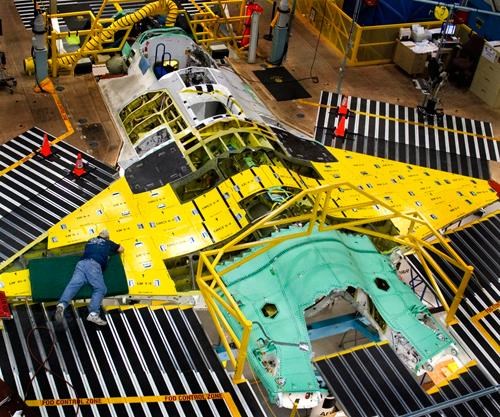I don't fully understand what you are saying. It will be easier for me to understand if you can tell me what the yellow pieces being attached to the wings are?
- Are they composite? It should be, because F-35's skin are supposed to be all composite?
- Is the yellow color from zinc chromate coating? Coated on the surface of composite (black/gray) sheet?
- If they are composite, doesn't it mean that being yellow or green is not indicative of what the underlying material is (metal or composite)? This is what I was trying to say.
That whole structure is the center fuselage/wing box, I don't have the engineering diagrams, or even a detailed construction manual... much of that is actually "classified", so I'm going to plead ignorance of all the details!
however, I'm going to walk you through this step by step, that forward fuselage section is uncoated, so its likely Titanium, in fact much of that center fuse/wing box structure is "welded up titanium, those fuselage "bulkheads" are indeed zinc chromated, and they support the fuselage skin.
Notice that the assembler is laying on a "pad", that bright yellow material he's laying on, is very likely the carbon fiber "skin", which is probably "bonded to the spar, ribs, leading edge etc. He's laying on a "pad" in order to prevent scratching or damage to the carbon fiber, which will induce a stressed area, which could affect the structural integrity of the carbon fiber.
Immediately behind the bright yellow is a bluish green skin section, the leading edge of which is serrated, that bluish green coated material appears to be "riveted" to the underlying surface, it could be aluminum or some alloy, or it could be titanium, notice the rear of the forward fuselage has a "gap" where the front of the engine will lay, so I'm going out on a limb and guessing that section is actually titanium as well???,,, it has to be very strong, that is a very, very, high stress area....
you will notice what is likely the titanium tub for the cockpit, and immediately aft of that the fuel bay, where the boomer flys the refueling probe in to refuel...
I'm going to stop here, but feel free to do a little research on basic structures, the fuselage has bulkheads, stringers, and upper fuselage longerons showing,, if you already understand those terms, then you will understand a little of what I'm trying to share with you...
the reason the aircraft in primer looks like a quilt, is because in preparartion for the outer coatings, each material has an underlying "primer" that protects and prepares that material to receive the outer coatings of RAM, indeed the F-22 in primer is indeed quite colorful, as is the F-35...
some of those "primers" may even be proprietary to Northrup Grumman who uses robotics to weld up that center fuse! or Lockheed Martin who receives that center fuse to be the "back-bone" of the whole build.
I hope this helps, it really is likely classified, but its also part of common practice in the US, China, and Russia, we all build airplanes in exactly the same manner.

